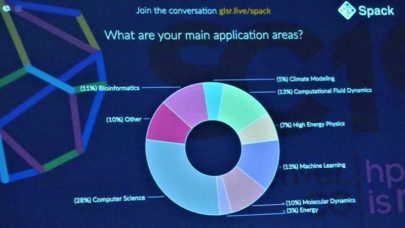
Julia Programming’s Dramatic Rise in HPC and Elsewhere
January 14, 2020
Back in 2012 a paper by four computer scientists including Alan Edelman of MIT introduced Julia, A Fast Dynamic Language for Technical Computing. At the time, t Read more…

CloudyCluster Helps Students Build Bright Futures in HPC
December 20, 2019
Looking for a future in HPC, some students literally taught themselves Python in a day while competing in the Cloud HPC Hackathon (also known as the Omnibond C Read more…

At SC19: Developing a Digital Twin
December 11, 2019
In the not too distant future, we can expect to see our skies filled with unmanned aerial vehicles (UAVs) delivering packages, maybe even people, from location to location. In such a world, there will also be a digital twin for each UAV in the fleet: a virtual model that will follow the UAV through its existence, evolving with time. Read more…

Finally! SC19 Competitors Live and in Color!
December 10, 2019
You know the saying “better late than never”? That’s how my cluster competition coverage is faring this year. With SC19 coming late in November, quickly f Read more…

On the Spack Track @SC19
December 5, 2019
At the annual supercomputing conference, SC19 in Denver, Colorado, there were Spack events each day of the conference. As a reflection of its grassroots heritage, nine sessions were planned by more than a dozen thought leaders from seven organizations, including three U.S. national Department of Energy (DOE) laboratories and Sylabs... Read more…

At SC19: Who’s Accountable ‘When Technology Kills’?
December 2, 2019
The relationship between humans and machines is inarguably one of the great issues of this century. Machine intelligence is rising at supersonic speed (see above); human intelligence is, at best, rising slowly. Machines, though bereft of EQ, can apply unimaginably, inhumanly high (and getting higher) IQ to its assigned tasks; human EQ can be nurtured... Read more…

SC19: IBM Changes Its HPC-AI Game Plan
November 25, 2019
It’s probably fair to say IBM is known for big bets. Summit supercomputer – a big win. Red Hat acquisition – looking like a big win. OpenPOWER and Power processors – jury’s out? At SC19, long-time IBMer Dave Turek sketched out a different kind of bet for Big Blue – a small ball strategy, if you’ll forgive the baseball analogy... Read more…

How the Gordon Bell Prize Winners Used Summit to Illuminate Transistors
November 22, 2019
At SC19, the Association for Computing Machinery (ACM) awarded the prestigious Gordon Bell Prize to the Swiss Federal Institute of Technology (ETH) Zurich. The Read more…

- Click Here for More Headlines

Whitepaper
Transforming Industrial and Automotive Manufacturing
In this era, expansion in digital infrastructure capacity is inevitable. Parallel to this, climate change consciousness is also rising, making sustainability a mandatory part of the organization’s functioning. As computing workloads such as AI and HPC continue to surge, so does the energy consumption, posing environmental woes. IT departments within organizations have a crucial role in combating this challenge. They can significantly drive sustainable practices by influencing newer technologies and process adoption that aid in mitigating the effects of climate change.
While buying more sustainable IT solutions is an option, partnering with IT solutions providers, such and Lenovo and Intel, who are committed to sustainability and aiding customers in executing sustainability strategies is likely to be more impactful.
Learn how Lenovo and Intel, through their partnership, are strongly positioned to address this need with their innovations driving energy efficiency and environmental stewardship.
Download Now
Sponsored by Lenovo
Whitepaper
How Direct Liquid Cooling Improves Data Center Energy Efficiency
Data centers are experiencing increasing power consumption, space constraints and cooling demands due to the unprecedented computing power required by today’s chips and servers. HVAC cooling systems consume approximately 40% of a data center’s electricity. These systems traditionally use air conditioning, air handling and fans to cool the data center facility and IT equipment, ultimately resulting in high energy consumption and high carbon emissions. Data centers are moving to direct liquid cooled (DLC) systems to improve cooling efficiency thus lowering their PUE, operating expenses (OPEX) and carbon footprint.
This paper describes how CoolIT Systems (CoolIT) meets the need for improved energy efficiency in data centers and includes case studies that show how CoolIT’s DLC solutions improve energy efficiency, increase rack density, lower OPEX, and enable sustainability programs. CoolIT is the global market and innovation leader in scalable DLC solutions for the world’s most demanding computing environments. CoolIT’s end-to-end solutions meet the rising demand in cooling and the rising demand for energy efficiency.
Download Now
Sponsored by CoolIT
Advanced Scale Career Development & Workforce Enhancement Center
Featured Advanced Scale Jobs:
HPCwire Resource Library
HPCwire Product Showcase
© 2024 HPCwire. All Rights Reserved. A Tabor Communications Publication
HPCwire is a registered trademark of Tabor Communications, Inc. Use of this site is governed by our Terms of Use and Privacy Policy.
Reproduction in whole or in part in any form or medium without express written permission of Tabor Communications, Inc. is prohibited.
























